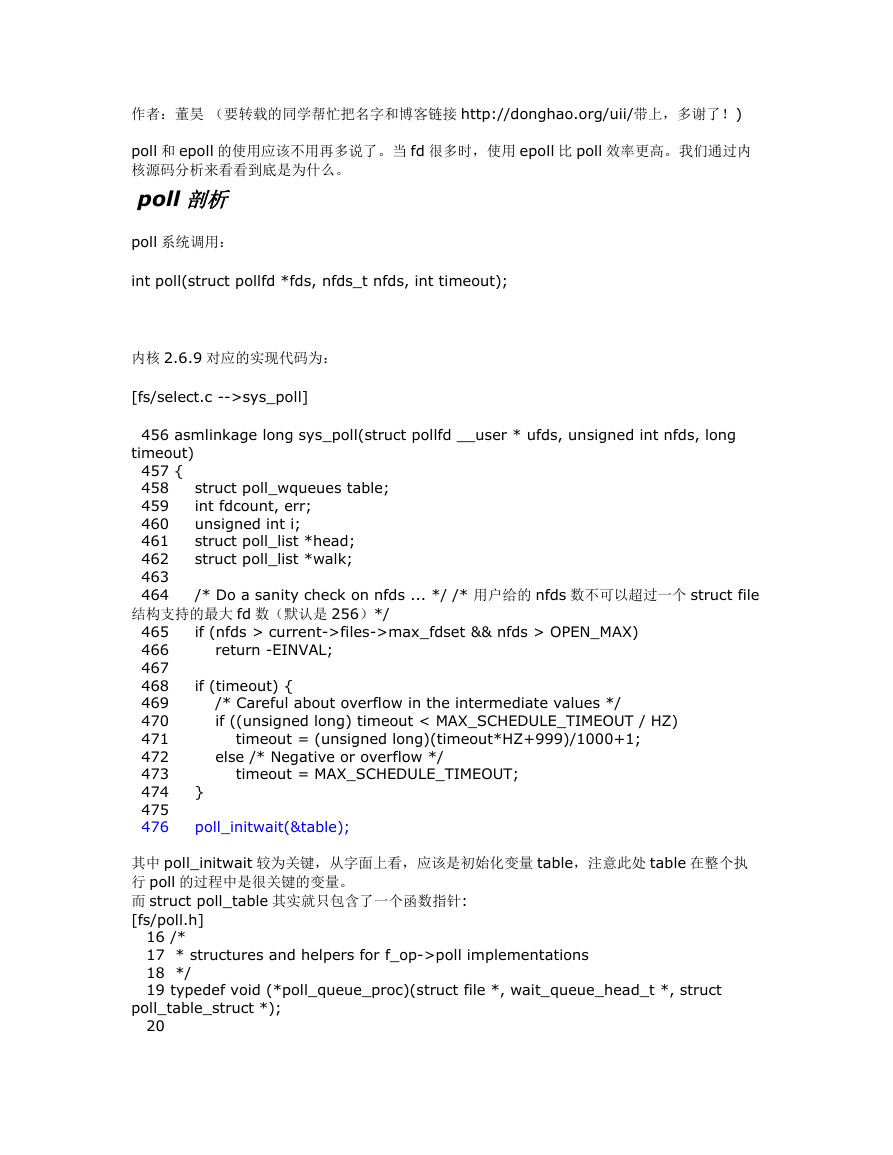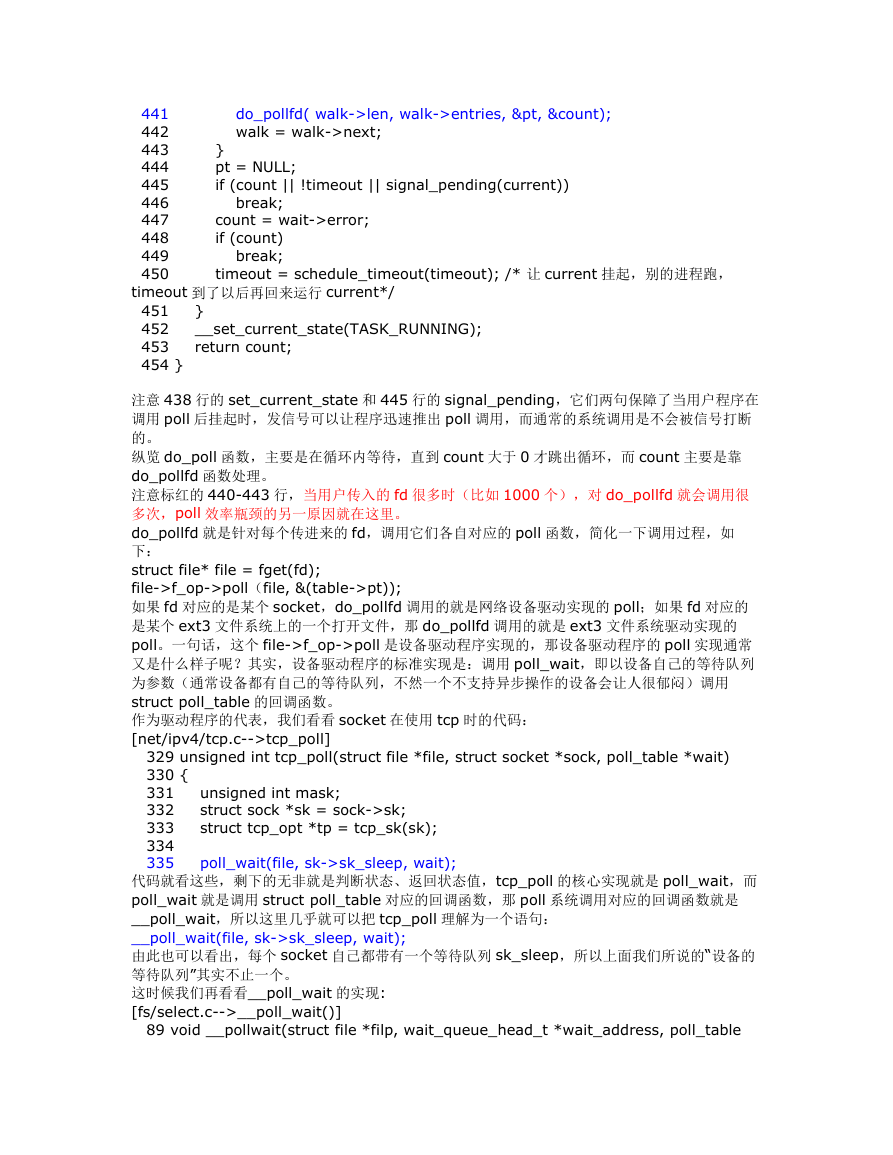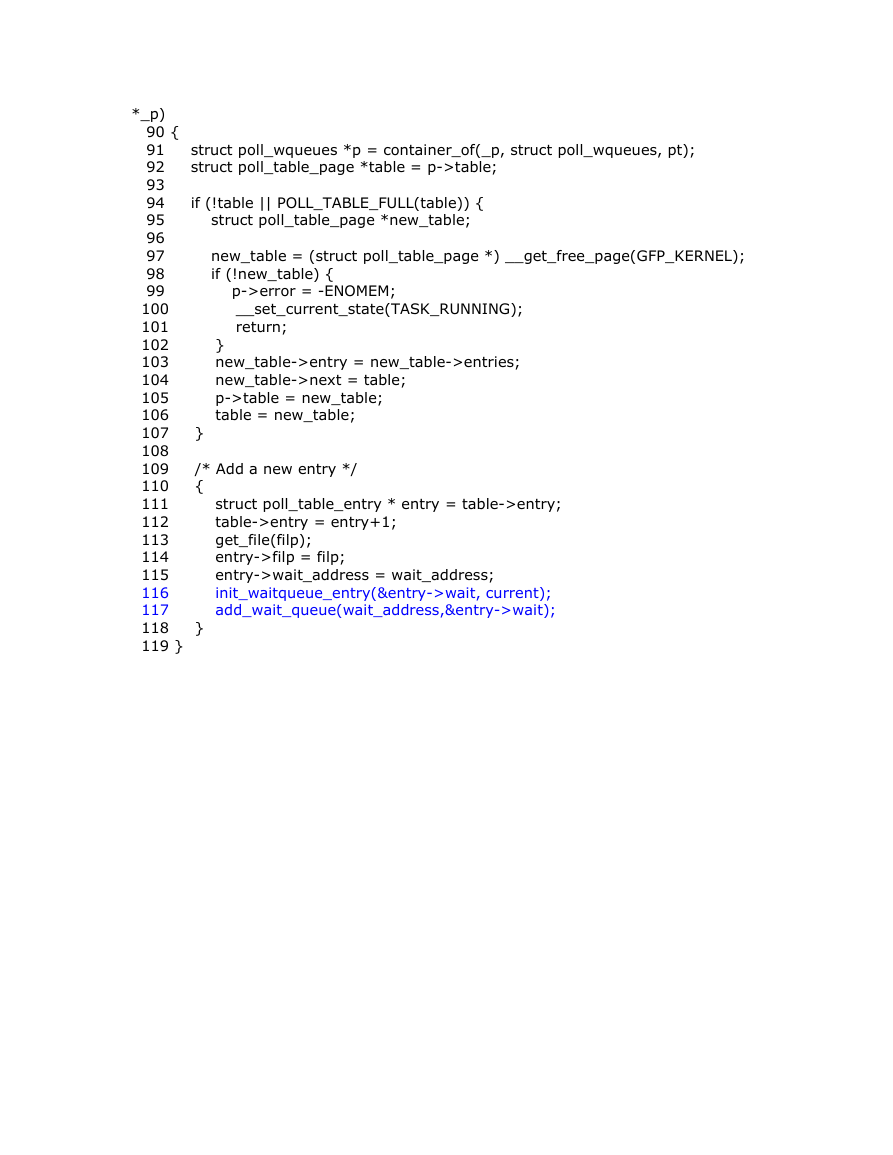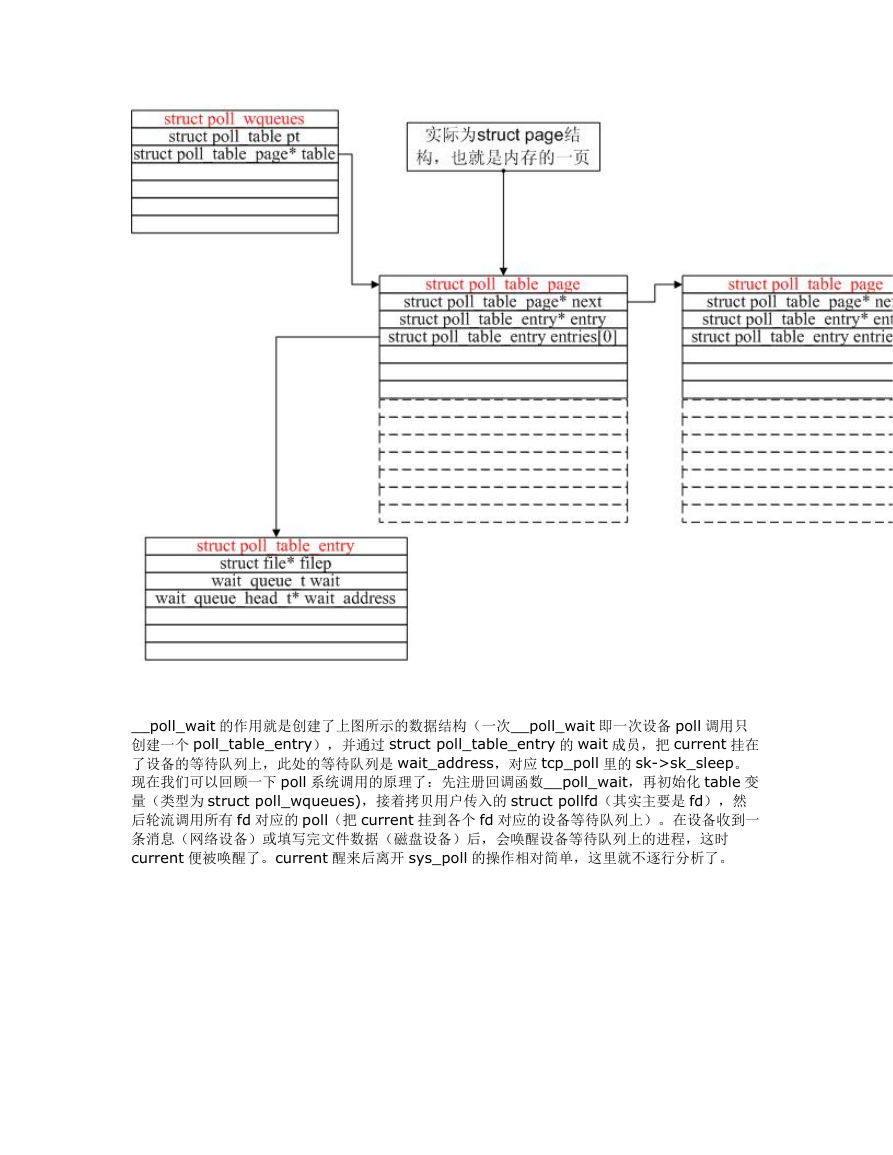作者:董昊 (要转载的同学帮忙把名字和博客链接 http://donghao.org/uii/带上,多谢了!)
poll 和 epoll 的使用应该不用再多说了。当 fd 很多时,使用 epoll 比 poll 效率更高。我们通过内
核源码分析来看看到底是为什么。
poll 剖析
poll 系统调用:
int poll(struct pollfd *fds, nfds_t nfds, int timeout);
内核 2.6.9 对应的实现代码为:
[fs/select.c -->sys_poll]
456 asmlinkage long sys_poll(struct pollfd __user * ufds, unsigned int nfds, long
/* Do a sanity check on nfds ... */ /* 用户给的 nfds 数不可以超过一个 struct file
结构支持的最大 fd 数(默认是 256)*/
if (nfds > current->files->max_fdset && nfds > OPEN_MAX)
/* Careful about overflow in the intermediate values */
if ((unsigned long) timeout < MAX_SCHEDULE_TIMEOUT / HZ)
timeout = (unsigned long)(timeout*HZ+999)/1000+1;
else /* Negative or overflow */
timeout = MAX_SCHEDULE_TIMEOUT;
其中 poll_initwait 较为关键,从字面上看,应该是初始化变量 table,注意此处 table 在整个执
行 poll 的过程中是很关键的变量。
而 struct poll_table 其实就只包含了一个函数指针:
[fs/poll.h]
16 /*
17 * structures and helpers for f_op->poll implementations
18 */
19 typedef void (*poll_queue_proc)(struct file *, wait_queue_head_t *, struct
poll_table_struct *);
20
timeout)
457 {
458
459
460
461
462
463
464
465
466
467
468
469
470
471
472
473
474
475
476
struct poll_wqueues table;
int fdcount, err;
unsigned int i;
struct poll_list *head;
struct poll_list *walk;
return -EINVAL;
if (timeout) {
}
poll_initwait(&table);
�
21 typedef struct poll_table_struct {
22
23 } poll_table;
poll_queue_proc qproc;
现在我们来看看 poll_initwait 到底在做些什么
[fs/select.c]
57 void __pollwait(struct file *filp, wait_queue_head_t *wait_address, poll_table
*p);
58
59 void poll_initwait(struct poll_wqueues *pwq)
60 {
61
62
63
64 }
&(pwq->pt)->qproc = __pollwait; /*此行已经被我“翻译”了,方便观看*/
pwq->error = 0;
pwq->table = NULL;
很明显,poll_initwait 的主要动作就是把 table 变量的成员 poll_table 对应的回调函数置为
__pollwait。这个__pollwait 不仅是 poll 系统调用需要,select 系统调用也一样是用这个
__pollwait,说白了,这是个操作系统的异步操作的“御用”回调函数。当然了,epoll 没有用这
个,它另外新增了一个回调函数,以达到其高效运转的目的,这是后话,暂且不表。
我们先不讨论__pollwait 的具体实现,还是继续看 sys_poll:
[fs/select.c -->sys_poll]
head = NULL;
walk = NULL;
i = nfds;
err = -ENOMEM;
while(i!=0) {
struct poll_list *pp;
pp = kmalloc(sizeof(struct poll_list)+
sizeof(struct pollfd)*
(i>POLLFD_PER_PAGE?POLLFD_PER_PAGE:i),
GFP_KERNEL);
if(pp==NULL)
goto out_fds;
pp->next=NULL;
pp->len = (i>POLLFD_PER_PAGE?POLLFD_PER_PAGE:i);
if (head == NULL)
walk = pp;
if (copy_from_user(pp->entries, ufds + nfds-i,
sizeof(struct pollfd)*pp->len)) {
head = pp;
else
walk->next = pp;
err = -EFAULT;
goto out_fds;
}
i -= pp->len;
478
479
480
481
482
483
484
485
486
487
488
489
490
491
492
493
494
495
496
497
498
499
500
501
502
503
504
505
}
fdcount = do_poll(nfds, head, &table, timeout);
这一大堆代码就是建立一个链表,每个链表的节点是一个 page 大小(通常是 4k),这链表节点
由一个指向 struct poll_list 的指针掌控,而众多的 struct pollfd 就通过 struct_list 的 entries
�
成员访问。上面的循环就是把用户态的 struct pollfd 拷进这些 entries 里。通常用户程序的 poll
调用就监控几个 fd,所以上面这个链表通常也就只需要一个节点,即操作系统的一页。但是,当
用户传入的 fd 很多时,由于 poll 系统调用每次都要把所有 struct pollfd 拷进内核,所以参数传
递和页分配此时就成了 poll 系统调用的性能瓶颈。
最后一句 do_poll,我们跟进去:
[fs/select.c-->sys_poll()-->do_poll()]
poll_table ** pwait, int *count)
int i;
for (i = 0; i < num; i++) {
int fd;
unsigned int mask;
struct pollfd *fdp;
mask = 0;
fdp = fdpage+i;
fd = fdp->fd;
if (fd >= 0) {
mask = DEFAULT_POLLMASK;
if (file->f_op && file->f_op->poll)
mask = file->f_op->poll(file, *pwait);
mask &= fdp->events | POLLERR | POLLHUP;
fput(file);
struct file * file = fget(fd);
mask = POLLNVAL;
if (file != NULL) {
395 static void do_pollfd(unsigned int num, struct pollfd * fdpage,
396
397 {
398
399
400
401
402
403
404
405
406
407
408
409
410
411
412
413
414
415
416
417
418
419
420
421
422
423
424
425 }
426
427 static int do_poll(unsigned int nfds, struct poll_list *list,
428
429 {
430
431
432
433
434
435
436
437
438
439
440
struct poll_list *walk;
set_current_state(TASK_INTERRUPTIBLE);
walk = list;
while(walk != NULL) {
int count = 0;
poll_table* pt = &wait->pt;
if (!timeout)
pt = NULL;
for (;;) {
}
if (mask) {
*pwait = NULL;
(*count)++;
}
}
fdp->revents = mask;
}
struct poll_wqueues *wait, long timeout)
�
do_pollfd( walk->len, walk->entries, &pt, &count);
walk = walk->next;
}
pt = NULL;
if (count || !timeout || signal_pending(current))
break;
count = wait->error;
if (count)
break;
441
442
443
444
445
446
447
448
449
450
451
452
453
454 }
timeout = schedule_timeout(timeout); /* 让 current 挂起,别的进程跑,
timeout 到了以后再回来运行 current*/
}
__set_current_state(TASK_RUNNING);
return count;
注意 438 行的 set_current_state 和 445 行的 signal_pending,它们两句保障了当用户程序在
调用 poll 后挂起时,发信号可以让程序迅速推出 poll 调用,而通常的系统调用是不会被信号打断
的。
纵览 do_poll 函数,主要是在循环内等待,直到 count 大于 0 才跳出循环,而 count 主要是靠
do_pollfd 函数处理。
注意标红的 440-443 行,当用户传入的 fd 很多时(比如 1000 个),对 do_pollfd 就会调用很
多次,poll 效率瓶颈的另一原因就在这里。
do_pollfd 就是针对每个传进来的 fd,调用它们各自对应的 poll 函数,简化一下调用过程,如
下:
struct file* file = fget(fd);
file->f_op->poll(file, &(table->pt));
如果 fd 对应的是某个 socket,do_pollfd 调用的就是网络设备驱动实现的 poll;如果 fd 对应的
是某个 ext3 文件系统上的一个打开文件,那 do_pollfd 调用的就是 ext3 文件系统驱动实现的
poll。一句话,这个 file->f_op->poll 是设备驱动程序实现的,那设备驱动程序的 poll 实现通常
又是什么样子呢?其实,设备驱动程序的标准实现是:调用 poll_wait,即以设备自己的等待队列
为参数(通常设备都有自己的等待队列,不然一个不支持异步操作的设备会让人很郁闷)调用
struct poll_table 的回调函数。
作为驱动程序的代表,我们看看 socket 在使用 tcp 时的代码:
[net/ipv4/tcp.c-->tcp_poll]
329 unsigned int tcp_poll(struct file *file, struct socket *sock, poll_table *wait)
330 {
331
332
333
334
335
unsigned int mask;
struct sock *sk = sock->sk;
struct tcp_opt *tp = tcp_sk(sk);
poll_wait(file, sk->sk_sleep, wait);
代码就看这些,剩下的无非就是判断状态、返回状态值,tcp_poll 的核心实现就是 poll_wait,而
poll_wait 就是调用 struct poll_table 对应的回调函数,那 poll 系统调用对应的回调函数就是
__poll_wait,所以这里几乎就可以把 tcp_poll 理解为一个语句:
__poll_wait(file, sk->sk_sleep, wait);
由此也可以看出,每个 socket 自己都带有一个等待队列 sk_sleep,所以上面我们所说的“设备的
等待队列”其实不止一个。
这时候我们再看看__poll_wait 的实现:
[fs/select.c-->__poll_wait()]
89 void __pollwait(struct file *filp, wait_queue_head_t *wait_address, poll_table
�
*_p)
90 {
91
92
93
94
95
96
97
98
99
100
101
102
103
104
105
106
107
108
109
110
111
112
113
114
115
116
117
118
119 }
struct poll_wqueues *p = container_of(_p, struct poll_wqueues, pt);
struct poll_table_page *table = p->table;
if (!table || POLL_TABLE_FULL(table)) {
struct poll_table_page *new_table;
new_table = (struct poll_table_page *) __get_free_page(GFP_KERNEL);
if (!new_table) {
p->error = -ENOMEM;
__set_current_state(TASK_RUNNING);
return;
}
new_table->entry = new_table->entries;
new_table->next = table;
p->table = new_table;
table = new_table;
}
/* Add a new entry */
{
struct poll_table_entry * entry = table->entry;
table->entry = entry+1;
get_file(filp);
entry->filp = filp;
entry->wait_address = wait_address;
init_waitqueue_entry(&entry->wait, current);
add_wait_queue(wait_address,&entry->wait);
}
�
__poll_wait 的作用就是创建了上图所示的数据结构(一次__poll_wait 即一次设备 poll 调用只
创建一个 poll_table_entry),并通过 struct poll_table_entry 的 wait 成员,把 current 挂在
了设备的等待队列上,此处的等待队列是 wait_address,对应 tcp_poll 里的 sk->sk_sleep。
现在我们可以回顾一下 poll 系统调用的原理了:先注册回调函数__poll_wait,再初始化 table 变
量(类型为 struct poll_wqueues),接着拷贝用户传入的 struct pollfd(其实主要是 fd),然
后轮流调用所有 fd 对应的 poll(把 current 挂到各个 fd 对应的设备等待队列上)。在设备收到一
条消息(网络设备)或填写完文件数据(磁盘设备)后,会唤醒设备等待队列上的进程,这时
current 便被唤醒了。current 醒来后离开 sys_poll 的操作相对简单,这里就不逐行分析了。
�












 2023年江西萍乡中考道德与法治真题及答案.doc
2023年江西萍乡中考道德与法治真题及答案.doc 2012年重庆南川中考生物真题及答案.doc
2012年重庆南川中考生物真题及答案.doc 2013年江西师范大学地理学综合及文艺理论基础考研真题.doc
2013年江西师范大学地理学综合及文艺理论基础考研真题.doc 2020年四川甘孜小升初语文真题及答案I卷.doc
2020年四川甘孜小升初语文真题及答案I卷.doc 2020年注册岩土工程师专业基础考试真题及答案.doc
2020年注册岩土工程师专业基础考试真题及答案.doc 2023-2024学年福建省厦门市九年级上学期数学月考试题及答案.doc
2023-2024学年福建省厦门市九年级上学期数学月考试题及答案.doc 2021-2022学年辽宁省沈阳市大东区九年级上学期语文期末试题及答案.doc
2021-2022学年辽宁省沈阳市大东区九年级上学期语文期末试题及答案.doc 2022-2023学年北京东城区初三第一学期物理期末试卷及答案.doc
2022-2023学年北京东城区初三第一学期物理期末试卷及答案.doc 2018上半年江西教师资格初中地理学科知识与教学能力真题及答案.doc
2018上半年江西教师资格初中地理学科知识与教学能力真题及答案.doc 2012年河北国家公务员申论考试真题及答案-省级.doc
2012年河北国家公务员申论考试真题及答案-省级.doc 2020-2021学年江苏省扬州市江都区邵樊片九年级上学期数学第一次质量检测试题及答案.doc
2020-2021学年江苏省扬州市江都区邵樊片九年级上学期数学第一次质量检测试题及答案.doc 2022下半年黑龙江教师资格证中学综合素质真题及答案.doc
2022下半年黑龙江教师资格证中学综合素质真题及答案.doc